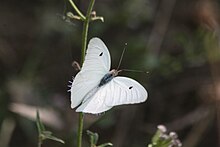Ganyra josephina
Jump to navigation
Jump to search
| Giant white | |
|---|---|

| |
| Scientific classification | |
| Domain: | Eukaryota |
| Kingdom: | Animalia |
| Phylum: | Arthropoda |
| Class: | Insecta |
| Order: | Lepidoptera |
| Family: | Pieridae |
| Genus: | Ganyra |
| Species: | G. josephina
|
| Binomial name | |
| Ganyra josephina | |
| Synonyms | |
| |
Ganyra josephina, the giant white, is a butterfly in the family Pieridae.
Subspecies
The following subspecies are recognized:[1]
- G. j. josephina - nominate subspecies (Hispaniola; Dominican Republic, Haiti)
- G. j. josepha (Salvin & Godman, 1868) (southern Texas, Mexico, Guatemala, Honduras, Nicaragua)
- G. j. krugii (Dewitz, 1877) (Puerto Rico, Mona Island)
- G. j. janeta (Dixey, 1915) (Venezuela , Trinidad)
- G. j. paramaryllis (Comstock, 1943) (Jamaica)
The former subspecies Ganyra josephina menciae, the Cuban white, has been separated as its own species, Ganyra menciae.[2]
Distribution and habitat
It is found from southern Texas through Mexico, the Caribbean and Central America to northern South America. The habitat consists of open, dry, subtropical forests.[3]
Description
The wingspan is 73–96 mm (2.9–3.8 in). Adults are on wing from September to December in southern Texas. They feed on flower nectar from a variety of weeds and garden plants including Lantana, Eupatorium and Bougainvillea.[3]
The larvae feed on older leaves of Capparidaceae species.[3]
References
Wikimedia Commons has media related to Ganyra josephina.
Wikispecies has information related to Ganyra josephina.
- ^ a b Ganyra, Site of Markku Savela
- ^ "Cuban White Ganyra menciae (Ramsden, [1914]) | Butterflies and Moths of North America". www.butterfliesandmoths.org. Retrieved 2024-01-31.
- ^ a b c Butterflies and Moths of North America